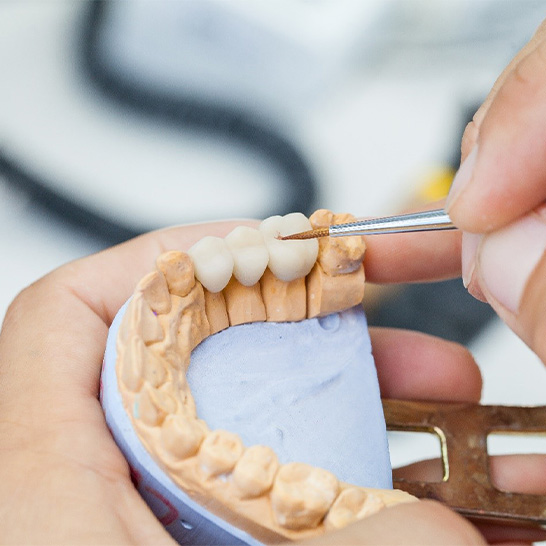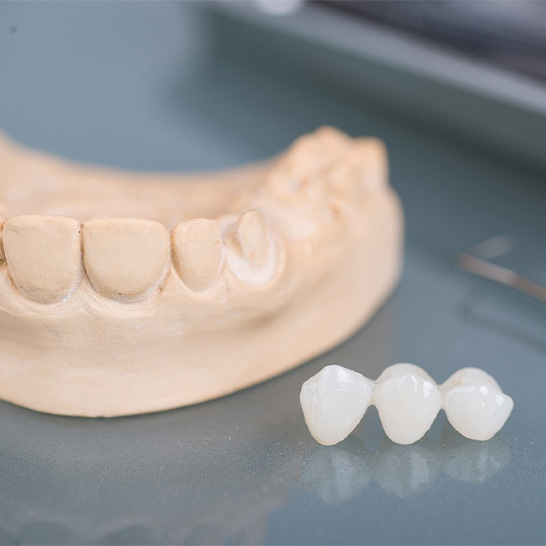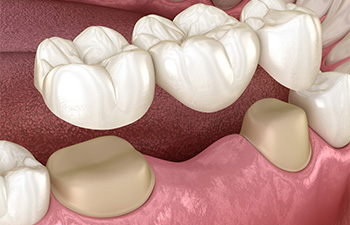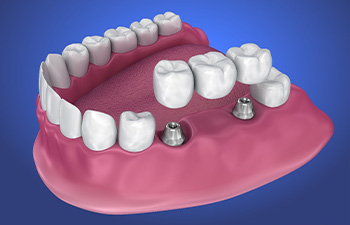Dental Bridges – Mission Viejo, CA
Get Rid of Your Smile’s Gaps

Losing just a single tooth tends to be bad enough. After all, such a situation does grave harm to your smile’s health and looks. It only follows that losing several adjacent teeth is far worse. Still, you can fix this second problem with dental bridges in Mission Viejo. We at Palm Dentistry place these devices to fill sizable smile gaps. If you’d like to learn more about them, please keep reading or book a visit with us!
What is a Dental Bridge?

Put simply, a dental bridge is a fixed restoration for your smile. It’s often made up of dental materials fused to either side of a pontic (i.e., an artificial tooth). Once placed, this device can replace up to four missing teeth at once.
Due to their features, dental bridges suit patients who’ve lost a few adjacent teeth. These candidates can have their entire grins restored with just one treatment. All the same, it doesn’t take much to get a dental bridge. Most adults can qualify for one if they’re in good health.
The Types of Dental Bridges

You’ll need to consult Dr. Palmer before you get a dental bridge. She’ll assess your smile to see whether treatment is a good idea. If she believes it is, she’ll draft a custom treatment plan for you. Following your consultation visit, we’ll review our findings and suggest one of two dental bridges to you. These types are the following:
Traditional Dental Bridge

Per its name, the traditional dental bridge is well-known. This device consists of dental crowns fused to the sides of a pontic. For that reason, it relies on nearby natural teeth for support.
Of the two kinds of dental bridges, a traditional one costs less. Its material is known to be rather inexpensive. However, the dentist does have to alter the support teeth (i.e., “abutments”) to place it. This work permanently removes some of the abutments’ enamel.
Implant Bridge

An implant bridge differs greatly from a standard one. Instead of dental crowns, it uses dental implants – small titanium posts – to secure itself. These posts are placed in your jaw and slowly fuse with it over time. That way, the final bridge remains steady and secure. It won’t loosen or fall like a denture could.
At the same time, an implant bridge doesn’t alter existing teeth. The dentist won’t need to “prep” any abutments to place it. In exchange, the device often costs more than the standard option.
The Benefits of Getting a Dental Bridge

Should you get a dental bridge, you’ll enjoy several notable perks. These include the following:
- A Gorgeous Grin – A dental bridge’s artificial teeth have porcelain surfaces. As a result, your treatment results should blend seamlessly with your smile.
- A Healthier Mouth – By filling your smile gaps, a dental bridge reduces the spread of harmful bacteria and keeps your other teeth from tilting.
- Easier Eating – Since it provides you with more teeth, a dental bridge helps you chew food. It’ll ensure you don’t struggle as much to have your favorite dishes.
- Lasting Results– On average, a dental bridge lasts 5-15 years. A maintained one can have a lifespan of 20+ years with proper care.
If teeth that once sat side-by-side go missing, trust a dental bridge to help. Please consider this amazing treatment and book a consultation visit to see us!
Dental Bridges FAQs
Can You Take a Dental Bridge Out?
Since dental bridges are anchored by crowns placed on the neighboring teeth or dental implants surgically placed in the jaw, they are designed to remain in a fixed position for years and can only be removed by a dental professional. While some healthcare professionals refer to partial dentures as “removable bridges,” this is not an accurate name. Dentures are designed to be easily removable by the patient while dental bridges are not.
Is Getting a Dental Bridge Painful?
Before performing the dental bridge placement procedure, your dentist will treat your mouth with a local anesthetic to render the process completely painless. If you are especially anxious about the treatment, you may receive dental sedation such as nitrous oxide. You may experience some dental sensitivity in the days after the dental bridge has been placed, but this can usually be managed with over-the-counter pain medication. However, contact your dentist if this discomfort seems to be getting worse. It’s important to remember that dental bridges can prevent your teeth from shifting out of place over time along with the uncomfortable oral health conditions that can cause. If you receive dental implants to support your bridge, you may experience some soreness afterward that can be minimized by complying with your aftercare instructions.
How Many Teeth Can a Dental Bridge Replace?
A dental bridge can replace anywhere from one to four sequential missing teeth, but they are usually used to replace only one or two. A longer dental bridge can be less stable, and this problem can become even worse if the teeth wearing the crowns supporting the bridge are not healthy. This sometimes makes replacing three or more teeth risky. However, implant bridges can lower the risk since dental implants provide the same strength and security as real teeth.
Do Dental Bridges Feel Natural?
Your dental bridge should feel increasingly natural within days of having it placed. Since they are made from durable materials that can withstand the pressures of everyday chewing, eating with them should feel perfectly comfortable. Each dental bridge is customized based on impressions taken of the teeth, and the teeth wearing the dental crowns support it are reshaped to provide maximum comfort. If you probe about your teeth with your tongue, you may notice a slight difference to the touch when you feel your bridge, but it should otherwise feel so comfortable and natural that you might forget it is there.
